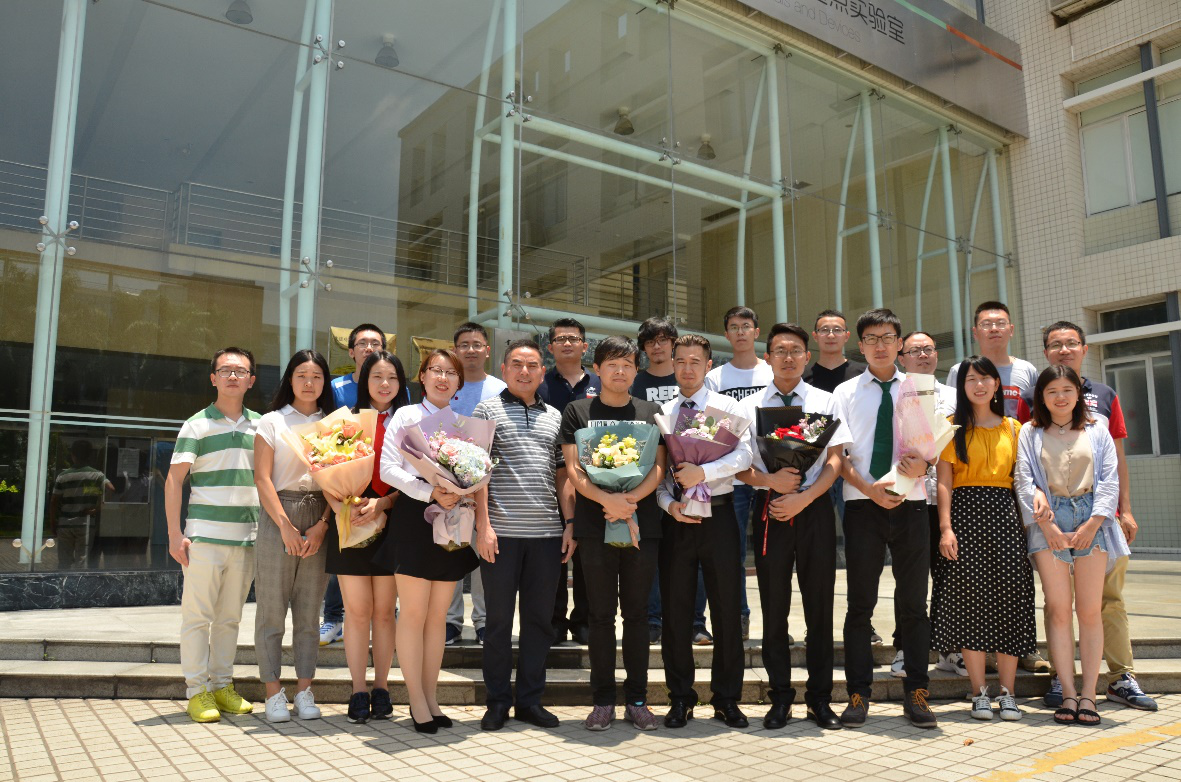
Prof. Shi-Jian Su, PhD
Recipient of The National Science Fund for Distinguished Young Scholars
Supported by Program for New Century Excellent Talents in University (NCET)
Email: mssjsu@scut.edu.cn
Office Phone: +86-20-22237098
Mobile Phone: +86-136-31368728
Biography:
Shi-Jian Su is a Professor of organic optoelectronic materials and devices at State Key Laboratory of Luminescent Materials and Devices (SKLLMD) and Institute of Polymer Optoelectronic Materials and Devices, South China University of Technology (SCUT), China. He graduated in 1993 and received his Master of Engineering degree in 1996, both from Xi’An Jiaotong University, China. He subsequently received his PhD from Yamagata University, Japan, in 2002 and then joined Prof. Junji Kido’s group as a postdoctoral fellow of Japan Society for the Promotion of Sciences (JSPS). From 2004, he joined Optoelectronic Industry and Technology Development Association as a research scientist. His current research interests include organic light-emitting materials and devices, purely organic room temperature phosphorescence materials, and perovskite light-emitting diodes.
Research interests:
Most recently, unity internal quantum efficiency (IQE) has been readily achieved for organic light-emitting diodes (OLEDs) through noble metal-free purely organic emitters, and the combination of conventional p-type hole-transport and n-type electron-transport materials in an appropriate device structure can also provide an uncommon efficiency. Both strategies are essential and attractive for high-performance and low-cost full-color displays and white OLED applications. Our research topic mainly focuses on this new generation of organic light-emitting materials and devices, including design, synthesis, and characterization of light-emitting organic molecules with tunable excited states, their structural, electrical, and photophysical properties, and corresponding devices. Devices with simplified structure, like planar p-n heterojunction OLEDs, are also developed to achieve reduced processing cost and improved performance. In addition, long-lived purely organic room temperature phosphorescence (RTP) materials that can also utilize triplet excitons for irradiation are also under investigation. Another research topic is lead halide perovskites that can also provide efficient blue, green, red and IR light-emitting diodes (LEDs). Recently, blue perovskite LEDs with long lifetime are investigated through a novel strategy of exploiting anti-solvent in the emitting layers.
 |
Group members:
Associate Professor: Dongcheng Chen
Post-doctors: Wei Li, Kunkun Liu, Xinyi Cai
PhD students: Lin Gan, Fanyuan Meng, Liangying Wang, Wentao Xie, Mengke Li, Weidong Qiu, Yiyan Gan, Xiaomei Peng
Master students: Yanmei He, Xinyan Liu, Wenqi Li, Qiumin Liang, Jiting Chen, Jianxian Li, Zijian Chen, Guanwei Sun
Selected Publications:
1. Gan, L.; Xu, Z.; Wang, Z.; Li, B.; Li, W.; Cai, X.; Liu, K.; Liang, Q.; Su, S.-J., Utilizing a spiro TADF moiety as a functional electron donor in TADF molecular design toward efficient “multichannel” reverse intersystem crossing. Adv. Funct. Mater. 2019, 29 (20), 1808088.
2. Cai, X.; Qiu, W.; Li, M.; Li, B.; Wang, Z.; Wu, X.; Chen, D.; Jiang, X.; Cao, Y.; Su, S.-J., Nonaromatic amine containing exciplex for thermally activated delayed fluorescent electroluminescence. Adv. Opt. Mater. 2019, 7 (9), 1801554.
3. Li, W.; Cai, X.; Li, B.; Gan, L.; He, Y.; Liu, K.; Chen, D.; Wu, Y.-C.; Su, S.-J., Adamantane-substituted acridine donor for blue dual fluorescence and efficient organic light-emitting diodes. Angew. Chem. Int. Ed. 2019, 58, 582-586.
4. Wang Z.; Li, M.; Gan, L.; Cai, X.; Li, B.; Chen, D.; Su, S.-J., Predicting operational stability for organic light-emitting diodes with exciplex cohosts. Adv. Sci. 2019, 6, 1802246.
5. Li, W.; Li, B.; Cai, X.; Gan, L.; Xu, Z.; Li, W.; Liu, K.; Chen, D.; Su, S.-J., Tri-spiral donor for high efficiency and versatile blue thermally activated delayed fluorescence materials. Angew. Chem. Int. Ed. 2019, 58 (33), 11301-11305.
6. Li, M.; Cai, X.; Qiao, Z.; Liu, K.; Xie, W.; Wang, L.; Zheng, N.; Su, S.-J., Achieving high-efficiency purely organic room-temperature phosphorescence materials by boronic ester substitution of phenoxathiine. Chem. Commun. 2019, 55 (50), 7215-7218.
7. Cai, X.; Qiao, Z.; Li, M.; Wu, X.; He, Y.; Jiang, X.; Cao, Y.; Su, S.-J., Purely organic crystals exhibit bright thermally activated delayed fluorescence. Angew. Chem. Int. Ed. 2019, 58, 13522-13531.
8. Meng, F.; Liu, X.; Cai, X.; Gong, Z.; Li, B.; Xie, W.; Li, M.; Chen, D.; Yip, H.-L.; Su, S.-J., Incorporation of rubidium cations into blue perovskite quantum dot light-emitting diodes via FABr-modified multi-cation hot-injection method. Nanoscale 2019, 11 (3), 1295-1303.
9. Cai, X.; Chen, D.; Gao, K.; Gan, L.; Yin, Q.; Qiao, Z.; Chen, Z.; Jiang, X.; Su, S.-J., “Trade-off” hidden in condensed state solvation: Multiradiative channels design for highly efficient solution-processed purely organic electroluminescence at high brightness. Adv. Funct. Mater. 2018, 28 (7), 1704927.
10. Li, B.; Gan, L.; Cai, X.; Li, X. L.; Wang, Z.; Gao, K.; Chen, D.; Cao, Y.; Su, S.-J., An effective strategy toward high-efficiency fluorescent OLEDs by radiative coupling of spatially separated electron-hole pairs. Adv. Mater. Interfaces 2018, 5, 1800025.
11. Wang Z.; Li, X. L.; Ma, Z.; Cai, X.; Cai, C.; Su, S.-J., Exciton-adjustable interlayers for high efficiency, low efficiency roll-off, and lifetime improved warm white organic light-emitting diodes (WOLEDs) based on a delayed fluorescence assistant host. Adv. Funct. Mater. 2018, 28 (11), 1706922.
12. Cai, X.; Su, S.-J., Marching toward highly efficient, pure-blue, and stable thermally activated delayed fluorescent organic light-emitting diodes. Adv. Funct. Mater. 2018, 28 (43), 1802558.
13. Chen, D.; Li, B.; Gan, L.; Cai, X.; Ma, Y.; Cao, Y.; Su, S.-J., Enhanced performances of planar heterojunction organic light-emitting diodes via diluting an n-type transporter into a carbazole-based matrix. J. Mater. Chem. C 2018, 6, 29-35.
14. Meng, F.; Zhang, C.; Chen, D.; Zhu, W.; Yip, H.-L.; Su, S.-J., Combined optimization of emission layer morphology and hole-transport layer for enhanced performance of perovskite light-emitting diodes. J. Mater. Chem. C 2017, 5 (25), 6169-6175.
15. Liu, M.; Komatsu, R.; Cai, X.; Hotta, K.; Sato, S.; Liu, K.; Chen, D.; Kato, Y.; Sasabe, H.; Ohisa, S.; Suzuri, Y.; Yokoyama, D.; Su, S.-J.; Kido, J., Horizontally orientated sticklike emitters: Enhancement of intrinsic out-coupling factor and electroluminescence performance. Chem. Mater. 2017, 29, 8630-8636.
16. Cai, X.; Gao, B.; Li, X. L.; Cao, Y.; Su, S.-J., Singlet–triplet splitting energy management via acceptor substitution: Complanation molecular design for deep-blue thermally activated delayed fluorescence emitters and organic light-emitting diodes application. Adv. Funct. Mater. 2016, 26 (44), 8042-8052.
17. Xie, G.; Li, X.; Chen, D.; Wang, Z.; Cai, X.; Chen, D.; Li, Y.; Liu, K.; Cao, Y.; Su, S.-J., Evaporation- and solution-process-feasible highly efficient thianthrene-9,9',10,10'-tetraoxide-based thermally activated delayed fluorescence emitters with reduced efficiency roll-off. Adv. Mater. 2016, 28 (1), 181-187.
18. Li, X. L.; Xie, G.; Liu, M.; Chen, D.; Cai, X.; Peng, J.; Cao, Y.; Su, S.-J., High-efficiency WOLEDs with high color-rendering index based on a chromaticity-adjustable yellow thermally activated delayed fluorescence emitter. Adv. Mater. 2016, 28 (23), 4614-4619.
19. Chen, D.; Xie, G.; Cai, X.; Liu, M.; Cao, Y.; Su, S.-J., Fluorescent organic planar pn heterojunction light-emitting diodes with simplified structure, extremely low driving voltage, and high efficiency. Adv. Mater. 2016, 28 (2), 239-244.
20. Chen, D.; Liu, K.; Gan, L.; Liu, M.; Gao, K.; Xie, G.; Ma, Y.; Cao, Y.; Su, S.-J., Modulation of exciton generation in organic active planar pn heterojunction: Toward low driving voltage and high-efficiency OLEDs employing conventional and thermally activated delayed fluorescent emitters. Adv. Mater. 2016, 28 (31), 6758-6765.
